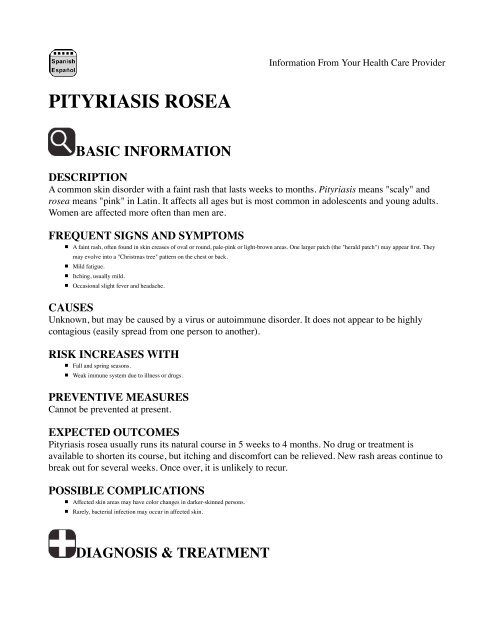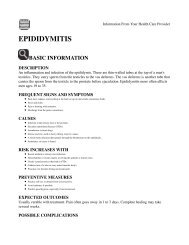Pityriasis Rosea.pdf
Pityriasis Rosea.pdf
Pityriasis Rosea.pdf
Create successful ePaper yourself
Turn your PDF publications into a flip-book with our unique Google optimized e-Paper software.
Information From Your Health Care Provider<br />
PITYRIASIS ROSEA<br />
BASIC INFORMATION<br />
DESCRIPTION<br />
A common skin disorder with a faint rash that lasts weeks to months. <strong>Pityriasis</strong> means "scaly" and<br />
rosea means "pink" in Latin. It affects all ages but is most common in adolescents and young adults.<br />
Women are affected more often than men are.<br />
FREQUENT SIGNS AND SYMPTOMS<br />
A faint rash, often found in skin creases of oval or round, pale-pink or light-brown areas. One larger patch (the "herald patch") may appear first. They<br />
may evolve into a "Christmas tree" pattern on the chest or back.<br />
Mild fatigue.<br />
Itching, usually mild.<br />
Occasional slight fever and headache.<br />
CAUSES<br />
Unknown, but may be caused by a virus or autoimmune disorder. It does not appear to be highly<br />
contagious (easily spread from one person to another).<br />
RISK INCREASES WITH<br />
Fall and spring seasons.<br />
Weak immune system due to illness or drugs.<br />
PREVENTIVE MEASURES<br />
Cannot be prevented at present.<br />
EXPECTED OUTCOMES<br />
<strong>Pityriasis</strong> rosea usually runs its natural course in 5 weeks to 4 months. No drug or treatment is<br />
available to shorten its course, but itching and discomfort can be relieved. New rash areas continue to<br />
break out for several weeks. Once over, it is unlikely to recur.<br />
POSSIBLE COMPLICATIONS<br />
Affected skin areas may have color changes in darker-skinned persons.<br />
Rarely, bacterial infection may occur in affected skin.<br />
DIAGNOSIS & TREATMENT
GENERAL MEASURES<br />
Your health care provider can usually diagnose the disorder by an exam of the affected skin. Medical tests may include blood studies. A scraping of the<br />
skin or a sample of the skin may be removed to examine under a microscope.<br />
No specific treatment will cure the disorder.<br />
Treatment can help relieve the itching. In more severe cases, treatment with ultraviolet light or moderate exposure to sunlight may be recommended.<br />
Bathe as usual with a mild soap. Use warm water, as hot water may increase the itching. Oatmeal baths may help.<br />
MEDICATIONS<br />
For minor discomfort, you may use nonprescription drugs, such as:<br />
Calamine lotion, to decrease itching.<br />
Steroid cream, to control more severe itching.<br />
Acetaminophen, to reduce fever.<br />
Other topical or oral steroids and antihistamines may be prescribed.<br />
ACTIVITY<br />
Avoid activities that cause excess sweating. This can make the rash worse.<br />
DIET<br />
No special diet.<br />
NOTIFY OUR OFFICE IF<br />
You or a family member has symptoms of pityriasis rosea.















